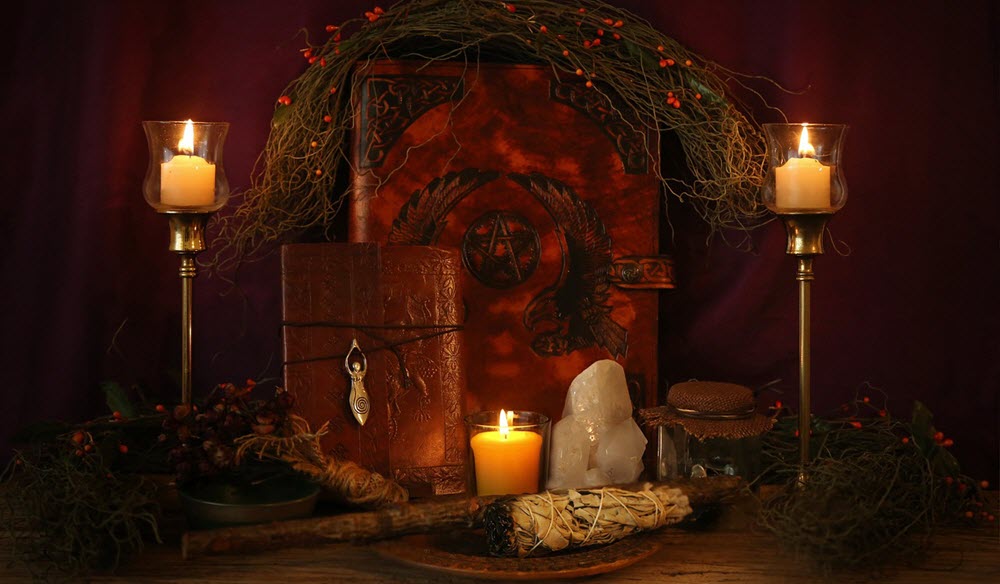Origins and Emergence
As we cast our gaze over a millennium, it is of great historical and cultural importance to examine the emergence and development of the Wiccan faith. Emerging in the mid-20th century, Wicca is a relatively modern pagan, witchcraft religion. It was popularized by figures such as Gerald Gardner and Doreen Valiente, who were instrumental in shaping Wicca’s foundational beliefs and practices.
Gerald Gardner and the Genesis of Wicca
Gerald Gardner, often referred to as the “Father of Wicca,” played a pivotal role in the initial establishment of the Wiccan faith. In the 1940s and 1950s, he claimed to have been initiated into a surviving coven of an ancient witch cult. Drawing upon various sources, including ceremonial magic, folk traditions, and Eastern philosophies, Gardner began to formulate what is now known as Gardnerian Wicca.

Doreen Valiente’s Contribution
Doreen Valiente, a prominent Wiccan Priestess, collaborated with Gardner and significantly influenced the early development of Wicca. She contributed to the creation of rituals, poetry, and liturgy and was a vehement advocate for Wicca as a religion.
Beliefs and Practices
Wicca is a highly diverse and decentralized religion with no single authoritative scripture or doctrine. However, there are some common beliefs and practices shared among Wiccans.
Reverence for Nature
Central to Wiccan spirituality is a deep reverence for nature and the cycles of the Earth. Many Wiccans observe the Wheel of the Year, which encompasses eight festivals known as sabbats, celebrating the solstices, equinoxes, and midpoints between them.
Deities
Wiccans often worship a dualistic deity, typically represented as the Goddess and the Horned God. The Goddess is commonly associated with the Earth and the moon, while the Horned God is associated with wildlife and the wilderness.
Magical Practices
Magic, as a means of affecting change in accordance with one’s will, is a significant aspect of Wiccan practice. Wiccans often perform rituals and spells, utilizing various tools such as athames, wands, and pentacles.
The Wiccan Rede and the Rule of Three
The ethical framework of Wicca is often encapsulated in the Wiccan Rede: “An it harm none, do what ye will.” This underscores the value of not causing harm to oneself or others. The Rule of Three, another common belief, holds that whatever energy a person sends out into the world, whether positive or negative, will be returned to them threefold.
Evolution and Expansion
Since its inception, Wicca has evolved into a multifaceted faith with numerous traditions and practices.
Traditions
Apart from Gardnerian Wicca, various traditions have developed, including Alexandrian, Dianic, and Seax Wicca. Each tradition has its unique practices and beliefs, though they often share common elements such as reverence for nature and the practice of magic.
Global Expansion
Initially a predominantly British phenomenon, Wicca has spread globally over the past millennium. It has garnered a diverse following across North America, Europe, Australia, and beyond. The internet and social media have further facilitated the spread and accessibility of Wiccan knowledge and communities.
Integration with Modern Culture
As Wicca spread through the world, it started integrating into popular culture. Books, movies, and television series began to incorporate Wiccan characters and themes, albeit often with considerable creative license. This cultural integration played a significant role in bringing Wicca into mainstream consciousness.
Wicca in the Context of Interfaith and Social Movements
Interfaith Dialogue
Wicca has increasingly participated in interfaith dialogues as a relatively new religious movement. Wiccans have sought to build bridges with practitioners of other religious traditions, contributing to a richer tapestry of global spirituality.
Environmental Activism
Given its inherent reverence for nature, Wicca has found a natural alignment with environmental movements. Many Wiccans have been vocal and active in environmental causes, seeing the protection of the natural world as a sacred duty.
Feminist Movements
Wicca’s emphasis on the divine feminine has also resonated with feminist movements. For many, the Wiccan Goddess has served as an empowering symbol of femininity and female strength. Consequently, Wicca has often been embraced by individuals seeking spiritual paths that affirm gender equality.
Wicca’s Place in the Spiritual Landscape
As we reflect on a millennium since the advent of Wicca, what stands out is the enduring appeal and adaptability of this spiritual path. From its genesis in mid-20th-century England to its global dissemination and cultural integration, Wicca has carved out a distinctive niche in the spiritual landscape of the world.
It is a testament to the universal longing for connection with nature, the sacred, and the mystical aspects of existence. The Wiccan faith, with its focus on harmony with the natural world, personal empowerment through magical practice, and reverence for both the feminine and masculine divine, continues to attract a diverse following.
As the world evolves, it remains to be seen how Wicca will continue to adapt and what role it will play in the ever-changing tapestry of human spirituality. Nonetheless, the Wiccan faith, still young in the grand timeline of religious history, has indelibly marked its presence.
